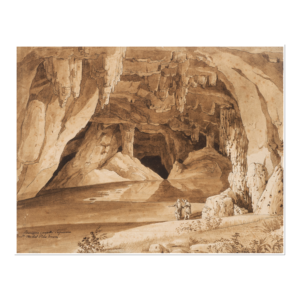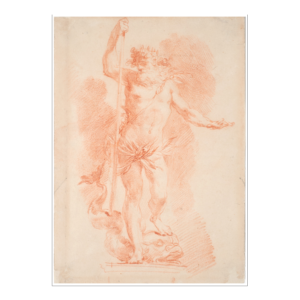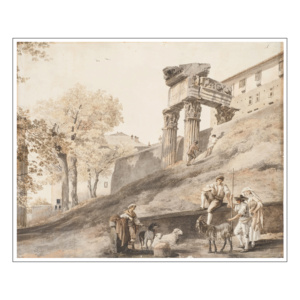Julien de Parme
Cavigliano, 1736 – Paris, 1799
Young man reclining against a tree extending his left arm towards two nude figures, barely sketched.
Sanguine.
227 x 350 mm – 8 15/16 x 13 ¾ in.
Unidentified watermark.
Signed and dated “J. de Parme, 1782”.
Provenance -Private collection, Paris; Galerie Paul Prouté (Cat n°106, December 1995, n°17, reproduced).
Bibliography: Julien de Parme, Catalogue of the exhibition in Rancate (Sept-Nov 99) and Parma (Feb-April 2000), edited by M. Pierre Rosenberg, ed. Skira, (n°63, reproduced p.138).
Jean-Antoine Julien was born on April 23, 1736 in Cavigliano, Ticino (Switzerland). He arrived in France at an early age, around 1747, where he began his artistic training. He benefited from the guidance of major art figures of the time, including history painter Carle van Loo and sculptor Michel-Ange Slodtz.
Early in his career, Julien led an itinerant life, traveling throughout France to paint portraits. This practice enabled him to finance his studies and develop his technique, but it did not offer him the stability or recognition he sought.
The crucial stage in his life and career came between 1760 and 1773. Julien travelled to Italy, where he studied in depth the remains of Antiquity in Rome and assimilated the lessons of the great Renaissance masters. His style evolved towards greater formal rigor, while retaining an elegance inherited from the Rococo period.
It was during this stay that he achieved a major distinction: he became the official painter of the Duke of Parma, Ferdinand I de Bourbon. This prestigious patronage gave rise to his famous nickname of “Julien de Parme”, to which he remained permanently attached. The works of this Italian period show a predilection for mythological and historical subjects.
In 1773, Julien de Parme returned to Paris with a style which, although elegant, prefigured the strict Neoclassicism of the following generation (that of Jacques-Louis David). Unfortunately, he failed to make a lasting impact on the Parisian art scene. His work was often misunderstood or misinterpreted by his contemporaries, as the public and critics were still largely attached to the lighter sensibilities of the time.
His final years were marked by financial difficulties and oblivion. He died in Paris on July 28, 1799, in relative destitution, and after his death, Julien de Parme’s work fell into long oblivion. He was often confused with his namesake, the painter Simon Julien, or even the sculptor Pierre Julien, his contemporaries.
His rehabilitation is relatively recent. Thanks to the research of Pierre Rosenberg and the Rancate and Parma exhibitions, his work is now recognized for its elegance and quality, and for having been a precursor of the neoclassical tendencies that were to dominate the Napoleonic era.
The 1999 exhibition catalog notes that our drawing is one of the few known to have been treated entirely in sanguine. It cannot be compared with any known composition.
Condition – Good overall condition, but with a vertical fold to the right corresponding to an earlier, tighter frame.
Louis XVI style gilded wood frame.








